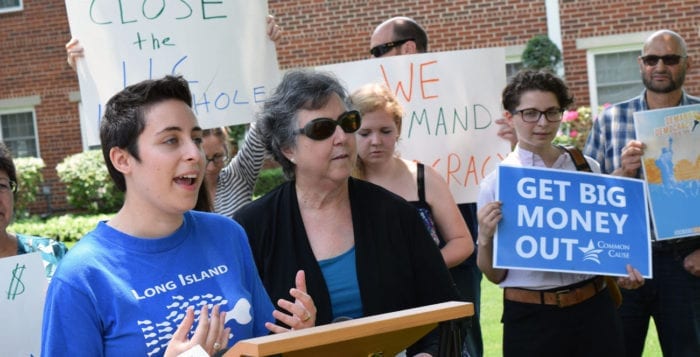With the race for outgoing U.S. Rep. Steve Israel’s seat heating up, a new contender from Nassau County has thrown his hat into the race.
Jon Kaiman (D-Great Neck) is one of five candidates seeking the Democratic nomination for the 3rd Congressional District seat, which spans from Northeast Queens, Huntington and Smithtown. Israel (D-Huntington), who has publicly endorsed Suffolk County Legislator Steve Stern (D-Dix Hills) for the job, has held the seat for the last 15 years but opted not to run for re-election.
At a press event last Thursday at Munday’s restaurant in Huntington, Kaiman said he’s felt some frustration with federal politics from his would-be constituents, but he’s confident his background and experience will help repair the relationship.
Kaiman previously served as North Hempstead’s town supervisor from 2004 to 2013. During that time he said he earned a reputation as a progressive Democrat willing to fight for social justice. He has also served as an advisor to New York Gov. Andrew Cuomo (D) on his Superstorm Sandy Disaster Relief Program that helped homeowners and businesses recover after the storm.
“Part of this role that we play when we present ourselves as leaders is to define ourselves in a way that other people can have confidence that they know who we are and where we can go,” Kaiman said. “I think I’ve done that throughout my own history.”
People can look through his record, he said, as it includes programs that brought improvements to the lives of those he served.
One program he created, Project Independence, provided more than 50,000 senior citizens with services, such as transportation to supermarkets and medical appointments and access to nursing services and more, in an effort to help seniors continue living safely in their own homes.
Kaiman also mentioned high interest rates that students are paying on loans as an example of the disconnect between government and people. Though he doesn’t agree with Democratic presidential candidate Bernie Sanders that college should be free, Kaiman said he appreciates the light Sanders is shining on the issue because something needs to change. His campaign website he says he stands with Planned Parenthood, supports gun control measures and wants to combat climate change.
He received an endorsement from the former Democratic majority leader of the Suffolk County Legislature, Jon Cooper. Cooper joins former Queens Congressman Gary Ackerman as some of the higher-profile endorsements Kaiman has received on the campaign trail.
“Jon is a lifelong progressive Democrat who stands by his core values,” Cooper said of Kaiman during last Thursday’s press event. “He’s not afraid to take a position that may not be popular. If you hold your finger up to the wind and just see which way the wind is blowing and follow the polls, that may be the safest and easiest thing to do politically, but a leader should be willing to lead. That’s one reason why I decided not to endorse the other candidates and why I’m endorsing this gentleman.”
Apart from Stern, Kaiman faces Tom Suozzi, former Nassau County Executive; Anna Kaplan, North Hempstead Town Board member; and attorney Jonathan Clarke.
Kaiman’s history of fighting for social justice and his ability to work across the aisle were some of his more attractive qualities as a candidate, according to Cooper, who likened the congressional hopeful to Vice President Joe Biden in that regard.
Kaiman lives in Great Neck with his wife and three children.
The congressional Democratic primary day for New York is June 28. The winner will face Republican nominee New York State Sen. Jack Martins.





















